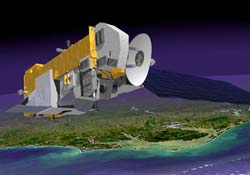NASA plans to put an Aura around the Earth

Aura satellite - artist’s concept
On June 19, NASA will launch Aura, a next generation Earth-observing satellite. Aura will supply the best information yet about the health of Earth’s atmosphere.
Aura will help scientists understand how atmospheric composition affects and responds to Earth’s changing climate. The satellite will help reveal the processes that connect local and global air quality. It will also track the extent Earth’s protective ozone layer is recovering.
Aura will carry four instruments each designed to survey different aspects of Earth’s atmosphere. The instruments will provide an unprecedented and complete picture of the composition of the atmosphere. Aura will survey the atmosphere from the troposphere, where mankind lives, through the stratosphere, where the ozone layer resides and protects life on Earth.
Aura’s space-based view of the atmosphere and its chemistry will complete the first series of NASA’s Earth Observing System satellites. The other satellites are, Terra, which monitors land, and Aqua, which observes Earth’s water cycle.
“Gaining this global view of Earth will certainly reap new scientific discoveries that will serve as essential stepping stones to our further exploration of the Moon, Mars and beyond – the basis of the Vision for Space Exploration,” said NASA Administrator Sean O’Keefe.
Aura will help answer key scientific questions, including whether the ozone layer is recovering. Aura data may prove useful determing the effectiveness of international agreements, which banned ozone-depleting chemicals like chlorofluorocarbons (CFCs).
Aura will accurately detect global levels of CFCs, and their byproducts, chlorine and bromine, which destroy ozone. Aura will also track the sources and processes controlling global and regional air quality. It will help distinguish between natural and human-caused sources of these gases. When ozone exists in the troposphere, it acts as an air pollutant. Tropospheric ozone is linked to high levels of precursors such as nitrogen dioxide, carbon monoxide and volatile hydrocarbons. Aura will help scientists follow the sources of tropospheric ozone and its precursors.
“Aura, the first comprehensive laboratory in space to help us better understand the chemistry and composition of the Earth’s atmosphere, is fundamentally a mission to understand and protect the very air we breathe, ” said NASA Associate Administrator for Earth Science Dr. Ghassem Asrar. “It is also a perfect complement to our other Earth Observing System satellites that, together, will aid our nation and our neighbors by determining the extent, causes, and regional consequences of global change.”
As the composition of Earth’s atmosphere changes, so does its ability to absorb, reflect and retain solar energy. Greenhouse gases, including water vapor, trap heat in the atmosphere. Airborne aerosols from human and natural sources absorb or reflect solar energy based on color, shape, size, and substance. The impact of aerosols, tropospheric ozone and upper tropospheric water vapor on Earth’s climate remains largely unquantified. Aura’s ability to monitor these agents will help unravel some of their mystery.
Aura’s four instruments, the High Resolution Dynamics Limb Sounder (HIRDLS); the Microwave Limb Sounder (MLS); the Ozone Monitoring Instrument (OMI); and the Tropospheric Emission Spectrometer (TES) will work together to provide measurements in the troposphere and stratosphere to help answer important climate questions.
HIRDLS was built by the United Kingdom and the United States. OMI was built by the Netherlands and Finland in collaboration with NASA. NASA’s Jet Propulsion Laboratory, Pasadena, Calif., constructed TES and MLS. NASA’s Goddard Space Flight Center, Greenbelt, Md., manages the Aura mission.
NASA’s Earth Science Enterprise is dedicated to understanding the Earth as an integrated system and applying Earth System Science to improve prediction of climate, weather, and natural hazards using the unique vantage point of space.
Media Contact
More Information:
http://www.gsfc.nasa.gov/topstory/2004/0517aura.htmlAll latest news from the category: Earth Sciences
Earth Sciences (also referred to as Geosciences), which deals with basic issues surrounding our planet, plays a vital role in the area of energy and raw materials supply.
Earth Sciences comprises subjects such as geology, geography, geological informatics, paleontology, mineralogy, petrography, crystallography, geophysics, geodesy, glaciology, cartography, photogrammetry, meteorology and seismology, early-warning systems, earthquake research and polar research.
Newest articles

Parallel Paths: Understanding Malaria Resistance in Chimpanzees and Humans
The closest relatives of humans adapt genetically to habitats and infections Survival of the Fittest: Genetic Adaptations Uncovered in Chimpanzees Görlitz, 10.01.2025. Chimpanzees have genetic adaptations that help them survive…

You are What You Eat—Stanford Study Links Fiber to Anti-Cancer Gene Modulation
The Fiber Gap: A Growing Concern in American Diets Fiber is well known to be an important part of a healthy diet, yet less than 10% of Americans eat the minimum recommended…

Trust Your Gut—RNA-Protein Discovery for Better Immunity
HIRI researchers uncover control mechanisms of polysaccharide utilization in Bacteroides thetaiotaomicron. Researchers at the Helmholtz Institute for RNA-based Infection Research (HIRI) and the Julius-Maximilians-Universität (JMU) in Würzburg have identified a…



